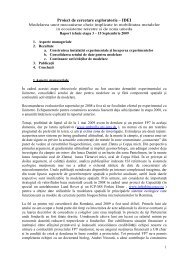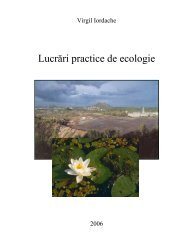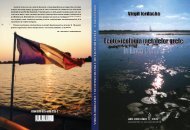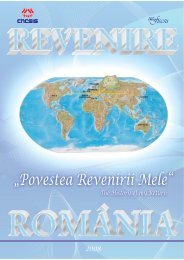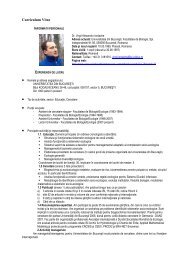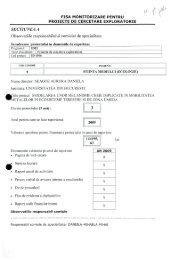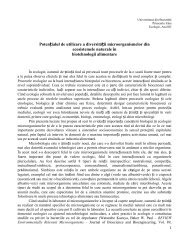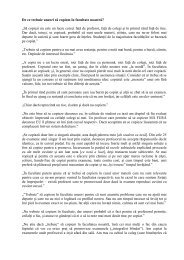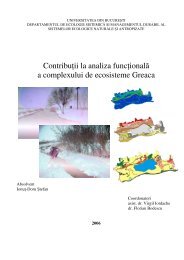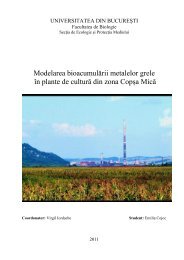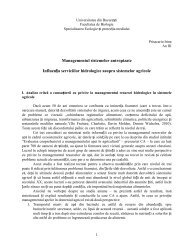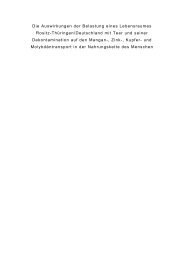PDFCreator, Job 14 - CESEC
PDFCreator, Job 14 - CESEC
PDFCreator, Job 14 - CESEC
- No tags were found...
Create successful ePaper yourself
Turn your PDF publications into a flip-book with our unique Google optimized e-Paper software.
Anal. t. I.D.D.Tulcea, Romaniavol. 10 2004Towards an integrated management of the lower Danube fisheriesIORDACHE VirgilUniversitatea din Bucuresti, Spl. Independentei 91-95, 76201 Bucuresti, e-mail: virgil@bio.bio.unibuc.roAbstract The purpose of this paper is to point out who could be the socio-economic actors interested inlobbying for an integrated development of Danube’s fluvial fisheries, and who could be the actorsinterested in lobbying against such a development. It results that, from the main users, very interested inthe integrated development of the Lower Danube Fisheries (i.e. LDRS) are the fishers, somehowinterested - the foresters, and not interested - the farmers. A ‘tactic’ for surpassing the seeminglydominating farmers’ lobby is suggested.Key words: fluvial system, Danube, integrated management, users, lobbyingIntroductionDevelopment is that part of the management aiming to initiate a new flow, or improving an existing flow, ofbenefits from the productive system. Development measures are not controlling or planning measures(management measures per se), but target the qualitative or quantitative change of the components of theenvisaged productive system (physical capital, human capital, cultural capital, and natural capital). Landuse changes made in order to change the flow of natural resources and services (such as the substitution,conversion or reconstruction of ecological systems) are development measures.The traditional and still dominant approach in fisheries management (and development, as part of themanagement) is to focus within the fishery itself for increasing benefits from the fishery. But there is also adirection change towards integrated fisheries management. In the integrated fisheries management theattention is paid to all relevant resources and services simultaneously, and, beside the rent generation,there is a focus also on people and local socio-economic systems including in their ecological footprint thefishery.The integrated management of coastal fisheries is becoming common (under the influence of Agenda 21 –Ch. 17 stipulations), due to a trend in recent years among agencies supporting development effort tobroaden aid to a ‘multi-sectoral’ model [2, 9]. However, the integrated management of fluvial fisheries isstill uncommon, despite the increasing knowledge concerning the resources and services provided byfluvial systems.It is worthy noting that in the case of riparian forest, included in structure of the fluvial systems, there is astronger trend towards integrated management [13]. Also, in the case of the riparian forests belonging tovery large fluvial systems, such as LDRS, the integrated management of forests cannot deal only with theriparian forests, but have to deal with the whole system, if it is to preserve the full range of resources andservices provided by the forests [16]. We underlined this aspect in order to point out that the integratedmanagement of riparian forests of very large fluvial systems envisages the same system as the integratedmanagement of the fisheries of large fluvial systems. If it is like this, one could prefer to speak aboutneither about the integrated management of fisheries, nor about the integrated management of riparianforest, but about the integrated management of the fluvial system. However, as we are here addressingmainly fishery scientists, we prefer to keep speaking about the integrated management of the fishery.In this context, the purpose of this paper is to point out who could be the socio-economic actors interestedin lobbying for an integrated development of Danube’s fluvial fisheries, and who could be the actorsinterested in lobbying against such a development.Materials and methodsThe material consisted in the literature published with regard to the Lower Danube fisheries management.The method was the critical analyses, including conceptual analyses where distinctions or similaritiesbetween terms were needed.Results and discussionsWe first show the identity, from ecological point of view, of the Lower Danube River System (LDRS) andthe Lower Danube Fisheries (LDF). Next we present what is supposed to be the integrated managementof LDF, according to existing scientific and managerial knowledge. Further we refer to conflicts of interestsrelated to the integrated development of LDF in function of different portfolios of societal developmentgoals. The last section deals with the tactic for promoting the integrated development in LDF.
Anal. t. I.D.D.Tulcea, Romaniavol. 10 2004Lower Danube fisheries vs. Lower Danube river systemFurther arguments towards the above aspects are given by the analyses of the definitions of LDRS and ofthe Danube fisheries.Vadineanu and his colleagues [30] describe LDRS as including the following major hydrogeomorphicalunits:• the Danube (Danube River and Iron Gates lakes), the floodplain (upstream floodplain, inner DanubeDelta, downstream floodplain), the Delta (core Danube Delta, Secondary Chilia Delta, Dranovfloodplain complex), Razim-Sinoie lagoon complex, and the Coastal Black Sea.The Romanian Fisheries Law 192/2001 includes in the natural fisheries (as mentioned in Art. 3), besidesother ecological systems, the following:• the Danube, the Delta, the floodplain, the Razelm-Sinoie complex, the Coastal Black Sea.Thus, the terms LDRS and LDF are two names of the same ecological system. However, while the nameLDRS is neutral with regard to the kind of resource and service produced by the system, LDF is biasedtowards the use of the fish resources produced by the system.One might argue that in the diked areas of the LDRS there is no fish, so no fishery. The reply would bethat LDRS is a spatial-temporal systems, and the lack of fish in diked areas characterizes the current state,but did not characterized the reference state (for instance that described in [3], or might not characterizethe future state, such as after reconstruction. Consequently in this paper we use interchangeably the twoterms (LDRS and LDF).Integrated management of lower Danube fisheriesOne can say that Antipa [3] promoted avant la lettre an integrated management of LDF, even if he waslimited by the knowledge concerning the resources and services provided by LDF at that time. The basicidea of his managerial efforts was to maximize the benefits obtained from the Royal lands located in theDanube floodplain, and in this respect he, lead by common sense, involved the local communities. What isdifferent today in the approach is the much better knowledge base about the natural capital and about thearray of resources and services, as well the recognition of the fact that incorporating in the managementplan of equity issues concerning the distribution of benefits between local and upper societal levels is amust, simply because groups with altruistic behavior of their individuals are more productive than egoisticgroups, as they spend fewer resources in managing the conflicts inherent to the functioning socioeconomicsystems [18].In the Danube Delta the Biosphere Reserve status asks explicitly for an integrated management [4], but inthe fisheries located upstream the Danube Delta fishery scientist currently seem to focus on a sectoralapproach in the management [27, 6]. They look mainly for improving the access rights, the institutionalsettings or the technical measures, even if there is a recognition of the fact that the low current stocks aredue mainly to hydrotechnical work and to decreasing water quality [24].The Danube River Basin Management, according with Water Framework Directive, is relevant for thedesign of the integrated management of LDF, but focus only on hydrological and biogeochemical services[15].Cristofor [10] coordinates a research that contributes to establishing the basis for an integratedmanagement plan of LDF. In the first chapter of this study it is shown [20] that an integrated managementplan of LDF is required in view of reaching the strategic, tactical and operational goals as stipulated in theNational Strategy for Sustainable Development [26]. The measures of the integrated management planhave to focus both on the natural capital and the socio-economic systems, including the institutionsresponsible for the designing and implementing the management, and have to be supported by anadequate integrated monitoring system [22]. One of the conclusions of the mentioned study is that at least120000 ha of diked wetlands in LDF upstream Delta have to be reconstructed [31]. The reason of thisreconstruction is the optimization of the resources and services offer of LDF, which now are at a pretty lowlevel, in agreement with the maximal potential of LDF (as indicated by the reference state) and with thecosts of the reconstruction (as indicated by the cost-benefit analyses).Thus, restoration is a demonstrated needed step in the integrated management plan of LDF. It is one ofthe development measures which have to be included in this plan. Restoration already started in polders ofthe Danube Delta, and proved to be effective [28]. But there is a bias between the Delta and the upstream
Anal. t. I.D.D.Tulcea, Romaniavol. 10 2004parts of LDF.The restoration of important floodplain areas is envisaged by the Program of ICPDR (ICPDR, 2001).According to this plan, Romania has to invest 73.9 millions Euro for restoring five local landscapes. Theobjectives of ICPDR for this restoration are related mainly to water quality improvement. The restorationsites are those established within the Lower Danube Green Corridor program promoted by WWF, and aregovernmentally supported also by the Declaration signed by Romania, Bulgaria, Ukraine, and Moldova inJune 2000. The sites do not include the major islands of the Inner Danube Delta (such as the Big Island ofBraila), former very important fisheries [3], dominated now by state agricultural farms, and proposed in partfor restoration [19], with research projects already dealing with aspects of the restoration plan [16, 17].The Lower Danube Green Corridor program promoted by WWF has larger objectives than the restorationenvisage by ICPDR, focusing on species diversity problems, ecosystems diversity problems, and waterquality problems, but it is far from an integrated approach of the problems of the local socio-economicsytems in relation with the natural capital (NC-SES). Starting from the Green Corridor concept one coulddevelop the idea of a Danube network of NC-SES systems promoting the integrated management. Twocomponents of such a network of integrated management areas are already functioning or in project: theDanube Delta Biosphere Reserve [4], and the Small Island of Braila Natural Park [1]. By using the GreenCorridor concept and the results of the study coordinated by Cristofor [10] one could design an effectivenetwork, whose emergent objective as a whole have to be the maintenance of the emergent services andresources of LDF [21] at levels of production acceptable for the SESs hierarchy (from local to nationallevel). In order to be able to do this, and to increase the long term benefits of the society, the competitionbetween local institutions involved in the management design of LDF should be avoided.One might ask why, if the integrated management is demonstrated as beneficial to society, it is scarcelyadopted by now in practice in LDF? The proposed answer is: because of the interests to keep the currentmanagement practices, and because of the competition between the institutional management designers.The second cause is targeted by the last part of the paper, so we focus here on the first cause.Management options arise in local, regional, national and even international political-institutionalconventions, rules and regulations. Stakeholder analyses focuses primarily on the people who have somekind of interest in the area and who will be positively or negatively affected in welfare terms by a change inthe ecological system’s management regime [8]. Suggested changes in management practices in theecological system may reduce or reinforce conflicts between the various interests involved. This may leadto resistance to the suggested change. From a policy point of view it is important to know how theseinterests can be balanced. In order to be able to do that, insight is needed into what the various interests inthe area are, who the stakeholder are and what the distribution of the positive and negative effects ofchanges in management regimes will be. Below we focus on the interests related to the adoption of anintegrated management with regard to LDF.Conflicts arising in view of the integrated management of LDFIn this part of the paper we present the identification of the kinds of stakeholder involved, based on thealready published functional analyses of current and restored LDF [21, 31]. The exact identification of thestakeholders in the LDF part located upstream the Delta is a complex objective, tackled only in part by now[7].There is no universal measure of the intensity of the interest. However, taking into account that in the totaleconomic valuation (done by using cost-benefit analyses) always is included a discount rate [2], we can inturn consider that the benefits of restoration appearing after a long time will rise lower interest than thoseappearing after shorter time, all the other variable being the same. Another important aspect is that wehave to make a difference between interests of stakeholder belonging to existing functional modules of thelocal SESs, and potential interests of the stakeholders corresponding to uses of the NC which are notoccurring in the current SESs, but can occur after restoration. These potential interests are in fact interestsfor an opportunity to use the NC in the future (after restoration), and cannot be directly related to certaincurrent type of users, although the management design might take into consideration a special type ofcurrent users to be reconverted towards the new opportunity of use.Another delineation that we have to make is between interests at the local level, and interests at thegovernmental level. We operationally define interests at the local level as those associated to resourcesand services that can generate directly wealth in the local SES (resources, potential for tourism, somehydrological and biogeochemical services), or in other words, are intercepted by the local SESs [<strong>14</strong>], andinterests at the governmental level those associated to services, which, even if generating wealth for manylocal socio-economic systems (many hydrological and biogeochemical services), can be managed only atgovernmental level. In this respect, Brouwer and his colleagues [8] point out that the values (evaluated by
Anal. t. I.D.D.Tulcea, Romaniavol. 10 2004the willingness to pay, thus reflecting the local SES level) associated with wetland functions very importantlocally (such as flood control or wildlife habitat provision) are higher than those associated with wetlandfunctions from which benefit not only the local SES (such water generation, water quality). On the otherhand, it is known the biogeochemical services associated with water quality generates most of the value ofa wetland surface unit in LDF [29]; the explanation arise from the fact that in the second case the value ofLDF water quality services is computed based on other methods, and reflecting the interest of thegovernment in reducing the discharge of nutrients into the Black Sea.Not least, we have to mention here we use the term “user of resource and/or service” as meaning not onlythose actors directly involved in the extraction of the resource, but also those actors which are verticallyintegrated with them or directly depending on them. For instance, the term “fishers” refer, in the discussionfrom below, to fishers, their households, those involved in the post harvest sector, those involved in thefishery management, and those involved in the assistance of the management (managers andresearchers). The same holds for “farmers”, and so on.Table 1 shows elements for analyzing the influence of the potential LDF development by restoration on thecurrent users interests for such a development. Table 2 shows the influence of the structure of the portfolioof societal development goals on the groups potentially lobbying for or against LDF development byrestoration.The main remarks to table 1 are:• most local users have to be interested in the restoration, including fishers; however, their lobbypotential is low, comparing with governmental users, but there is an advantage arising from the factthat increasing benefits from CN at local SES level are in agreement with the Agenda 21 principlesand the National Strategy for Sustainable Development;• foresters, with benefits mostly at governmental level, so with high lobby potential, may be interested inrestoration, but to a low degree because of the long time until benefits manifestation after restoration;• farmers (with high lobby potential) may be strongly against restoration, as the benefits related to thiskind of use will strongly decrease after restoration. It must be noted the economic inefficiency of manydiked areas [28, 29], some of them recently keeping a high profile even in the mass media, whichpoints out, for instance the big economic problems of the administration of the Big Island of Braila.However, as long as most of the diked areas are state property, the economic inefficiency can bemasked by governmental measures, so apparent benefits could arise as the result of public subsidies;• conditions for tourism in restored areas of LDF would be strongly improved after restoration, but thereare no current users at local level to lobby for this; some support could be found only at the specificgovernmental level;• water quality services will be strongly improved after restoration; however the setting of restoration fornutrients retention is already negotiated [15], even if it is not satisfactory from the point of view of otherresources and services.The main remarks to table 2 are:• The portfolio of objectives should include at least the objectives 1-4; adding the objectives of equityand employment to the basic objectives would strongly enhance the interest at local socio-economiclevel;• The Romanian administration [23] notes that the increase in fish export is limited, beside others, bythe fact that there is not, on foreign markets, a high demand for the currently offered dominantspecies. Restoration of LDF might change the situation in this respect, as well as in the dimension ofthe stocks, thus contributing to objective 5.• Fishery post-harvest sector development as a result of increasing stocks might contribute to objective8;• Objective 7 might be appropriate for the LDF district socio-economic systems, which are sufferingfrom economic and social problems [7], as well as objective 6 for the local socio-economic systems,taking into consideration their current depopulation trend [11, 7];• Thus, the objectives 5 to 8 might also be included in the portfolio, in function of the conjecturalgovernmental priorities.• There is a potential conflict of interest between farmers and other sector with regard to the integrateddevelopment of LDF. Such intersectoral conflicts are recognized at governmental level in terms ofconflicts between the strategies for the development of different sectors: extraction, agriculture,forestry, energetic, tourism [23].There is a governmentally recognized need to change the management system of the fishery sectors [23].But when the users have the feeling that they cannot control the direction of the management there is nogreat political pressure to be proactive. One needs, if it is allowed to speak in chemistry terms, a cataliserto activate the advantaged stakeholder, and to promote the “reaction” of transforming an inefficient
Anal. t. I.D.D.Tulcea, Romaniavol. 10 2004management of LDF into an efficient one by lowering the “activation energy” due to the current potentialconflicts of interests. A tactic for determining such catalyses is proposed below.Table 1 Elements for analyzing the influence of the potential development of LDF by restoration onthe current users interests for such a development.Resource / serviceDirection ofchange afterrestorationTime of benefitsmanifestationafter changeCurrent user /managerLevel of finalcurrentdominantbeneficiaryResourcesFish ++ medium fishers LWood and game species + long foresters NL (Gov)Medicinal plants, honey ++ medium villagers LSystematic agricultural crops - - NA farmers NL (Gov)Traditional agricultural crops + medium villagers LServicesMaintenance of species diversity++ long MWEP NLand ecological systems diversityAbsorption of secondary products 0 NA industry LWater quality improvement ++ short/medium MWEP NLFlood mitigation ++ short MWEP LRegional microclimate++ medium MWEP NLimprovement and groundwaterrechargeConditions for tourism ++ long none* LTransportation pathway 0 NA transporters LRemarksDirectly relatedto the intensity ofthe user interestfor restorationmanifestation afterlong timedecreases theintensity of theinterestIf there is nocurrent user,there is nocurrent interestFinalbeneficiariesat G level aremoreinfluential thanthose at LlevelLegend: “+, ++” = increase in the production of resource/service, NA = not applicable, MWEP = Ministry ofWater and Environmental Protection, L = local (within LDF), NL = not-local, Gov = governmental, *excepting for Danube Delta and Small Island of BrailaTable 2 Elements for choosing the portfolio of objectives which maximize the potential interest forthe development of LDF by large scale reconstruction.Societal objective of the LDF managementPotentially ForPotentially AgainstG L G LBasic objectives1 Sustainable production of high level of naturalfisher fishers farmers farmersresources and services2 Economic efficiency, economic viabilityforestersMWEPforestersOptional objectives3 Distribution equity Gov LA4 Employment Gov LA5 Export promotion and generation of foreignGovexchange6 Decreasing urban-rural drift Gov7 Maintaining a regional balance of development Gov8 Industry diversification GovLegend: G = at governmental level, L = at local level, Gov = governmental, LA = local administration,MWEP = Ministry of Water and Environmental Protection.Tactic for promoting the integrated development of LDFThe opportunity for values of the natural capital (as reflected in the integrated management plans) to beincorporated into societal decision making is an indicator of the health of a democracy [25]. This meansthat in a healthy democracy the flux of resources and services absorbed form the natural capital is higherthan in the absence of such democracy, because of the possibility of developing and implementingintegrated management plans, which is not surprising, taking into consideration that healthy democraciesbelongs to SESs in an advanced succession stage [18]. In medium advanced SESs governments do not
Anal. t. I.D.D.Tulcea, Romaniavol. 10 2004maximize the wealth of the society, because of the low quantity of resources which people are able toinvest in the public control of the government (op. cit.). Thus, in such countries governments have to bepersuaded be other means to increase the quality of the services that they provide to the society. Theaspects relevant to such persuasion are: pointing out the favorable elements for lobbying the integratedmanagement of LDF, establishing the tactical objectives, delineating the tactical plan.Favorable elements for lobbying are:1. Most diked areas are economically inefficient;2. The International Commission for the Protection of Danube River already promotes restoration;3. Foresters have strong lobbying capacity and might be interested in the integrated management;4. There is experience in designing the integrated management both in Danube Delta and the SmallIsland of Braila (INCDDD Tulcea and University of Bucharest);5. Other research and development institutions might be interested to be involved in designing theintegrated management plan of LDF started from existing work, and consequently in the lobby (“LowerDanube University” of Galati, Academy Institute of Biology IBIOL, Academy Institute of Geography,Research and Development Institute for Environmental Protection – ICIM Bucuresti, RomanianInstitute for Marine Research)6. IAD [6] is committed to be involved in the conservation of the floodplain along the Danube and itstributaries;7. RAMSAR and WWF have strong lobbying capacity, and might be interested in the lobbying for theintegrated management of LDF;8. International financial sources (GEF, UNDP, UNEP, World Bank) tend to promote projects ofintegrated development.Tactical objectives could be:1. The integrated management of the Lower Danube Fisheries to become a stated goal at the RomanianGovernment level; next2. The development of integrated management plans of key diked areas as part of a complex integratedmanagement plan of LDF to become priority for the Romanian Government in view of internationalfinancingThese objectives can be seen as part of the Action Plan for the implementation of the National Strategy forSustainable Development [29]As for the tactical plan for achieving the objectives we propose a systems approach consisting in couplinga bottom-up approach (from local level to Romanian Government) with a top-down approach (from ICPDRto the Romanian Government).The bottom up approach would include:• constructing a core task force including the mentioned research and academic institutions;• attracting forestry research in this task ;• developing a project for attracting the local administration of LDF SESs in the taskforce; these projectcould be run in consortium by the institutional partners, or by a widely recognized professionalorganization (such as, for instance, the Romanian Society of Ecology);• identifying viable alternative of livelihood for farmers at local level by running specific projects;• applying in consortium for local funding a major research project for advancing in the design of theintegrated management plan;• keeping a high profile in the media and developing contacts with NGOs capable of adding value to theexisting group of partners;• contacting the main political parties for promoting the adoption of the tactical objectives.It is known that the short time span of the governments’ life limit their appetite to take practical initiativeson the long term, unless there are no clear media benefits for the involved parties and politicians. Thus,the task force should focus not only on scientific aspects, but must have a strong interface to public and ahigh profile in the media.Financing of the task force can be done in the first phase by the involved partners to cover humanresource input and communication costs. In the second phase special costs can be included in theprojects developed by the local consortium. Competition of local institutions for local and internationalfunding which generally limit the formation of local consortiums, should be given up to the maximumpossible extent, because the societal role of scientist is not only to do science and obtain directadvantages from this, but also to promote general human values as reflected in the public good. Formationof local consortiums which are further integrated in international consortiums is feasible, as demonstratedby recently financed EU projects [12]. Thus, scientists belonging to different institutions should normally be
Anal. t. I.D.D.Tulcea, Romaniavol. 10 2004motivated to start building the task force, by material medium term interest and by interests related to thesocietal status.And the top-down approach would include:• proposing to IAD the formation of a new IAD work group dealing with the integrated management ofthe Danube System;• using this work group for developing a Danube’s international consortium for developing a project for6 th FP, as discussed during the 34 th IAD Conference (Tulcea, 2002);• using this work group for promoting the organization of similar task forces in the Danubian countries;• contacting RAMSAR and WWF and proposing them to support the idea;• accessing ICPDR, and promoting the idea of a Danube’s network of areas with integratedmanagement, mainly by IAD, but also by other organizations with observer status at ICPDR, such asRAMSAR and WWF.Conclusions1. The change of the current Green Corridor into a network of SES-NC systems managed in anintegrated manner will increase the societal benefits arising from LDF;2. A needed developmental measure in the regional integrated management plan is the extensiverestoration of the floodplain, at a higher level than the current Green Corridor;3. There are potential conflicts of interests in view of the integrated management of LDF putting, roughly,farmers on the one part and the others on the other part;4. There have been proposed tactical objectives of the lobbying for an integrated management of LDF;5. It was proposed a tactic for promoting the objectives by national and international lobbying;AcknowledgementsI would like to thank to Dr. Navodaru and Dr. Banks who kindly provided me their PowerPointpresentations at the 10 th Danube Delta Institute Symposium, and also to Blackewell Publishing who sentme reference [9] free of charge. This paper is a result of the lectures that I have made at the University ofBucharest on the subject of fisheries management in the period 1999-2002.References1. ADAMESCU (M.), BODESCU (F.), DANIELESCU (S.), CAZACU (C.), VALCU (M.), IGNAT (G.),VADINEANU (A.), 2001 - Integrated management plan for the Small Island of Braila, 120 p. Universityof Bucharest, Department of Systems Ecology2. ADGER (W. N.), KELLY (P. M.), TRI (N. H.), 2001 - Costs and benefits of mangrove conversion andrestoration. In: Economics of Coastal Water and Resources: Valuing Environmental Functions (edit. R.K. Turner, I. J. Bateman and W. N. Adger), pp. 259-280, Kluwer Academic Publisher, Dordrecht3. ANTIPA (G.), 1910 - Danube flooding area. Actual status and means of valorification, 318 p. Instit. deArte Grafice Carol Gobl, Bucuresti,4. BABOIANU (Gr.), 2002 - The role of the biosphere reserve for biodiversity protection and sustainabledevelopment in the Danube Delta, Internat. Assoc. Danube Res., 34, 633-6425. BACALBASA-DOBROVICI (N.), 2002 - Is the carmacs fishing in the Lower Danube and in theRomanian territorial waters an advantage to the riverine Danube countries, Internat. Assoc. DanubeRes., vol. 34, pp. 459-4666. BLOESCH (H.), 2002 - The river Danube – between conservation and restoration, Internat. Assoc.Danube Res., vol. 34, pp. XV-XX7. BODESCU (F.), BOTEZATU (M.), IORDACHE (V.), 2001 - Characterization of the SESs having intheir ecological footprint natural capital of LDRS. In: The Ecological Network of the Lower Danube(REDI) (edit. Cristofor, S.), pp. 77-82, Report to Major Research Project C89, University of Bucharest,Department of Systems Ecology8. BROUWER (R.), BATEMAN (I. J.), TURNER (R. K.), ADGER (W. N.), BOAR (R.), CROOKS (S.),DOCKERTY (T.), GEORGIOU (S.), JONES (A.), LANGFORD (I. H.), LEDOUX (L.), NISHIKAWA (N.),POWE (N.), WRIGHT (J.), WRIGHT (S. D.), 2001 - Management of a multi-porpose coastal wetland:the Norfolk and Suffolk Broads, England. In: Economics of Coastal Water and Resources: ValuingEnvironmental Functions (edit. R. K. Turner, I. J. Bateman and W. N. Adger), pp. 159-2<strong>14</strong>, KluwerAcademic Publisher, Dordrecht9. CHARLES (F.), 2001 - Integrated Fisheries Management, 300 p. Blackwell Publishing, Oxford10. CRISTOFOR (S.) (co-ordinator), 2000 - The Ecological Network of the Lower Danube (REDI).190 p.Report to Major Research Project C89, University of Bucharest, Department of Systems Ecology.11. EARTH VOICE ROMANIA, 1998 - Evaluation of the sustainable turism potential of Inner DanubeDelta. 60 p. Earth Voice Romania, Bucharest
Anal. t. I.D.D.Tulcea, Romaniavol. 10 200412. ERGENZINGER (P.) (co-ordinator), 1999 - Hydraulic, Sedimentological and Ecological problems ofMultifunctional Riparian Forest Management – RipFor. 40 p. Technical Annex, Free University ofBerlin, Berlin13. GEORGESCU (D.), IORDACHE (V.), BOTEZATU (M.), 2001 - Human ecology, 210 p. Ed. ArsDocendi, Bucharest<strong>14</strong>. ICPDR, 2001 - Joint action programme for the Danube River Basin. 50 p. ICPDR, Wien15. IORDACHE (V.), 2002 - Technical Annex of NAS extension project to main RipFor project. 17 p.University of Bucharest, Bucharest16. IORDACHE (V.), 2003 – Human ecology: a systems perspective, Analele Stiintifice al Universitatii Al.I. Cuza Iasi, Serie Biologie Animala, vol. XLIX, pp. 329-33617. IORDACHE (V.) (co-ordinator), 2002 - Assessment of the pollutants export potential from Big Island ofBraila in case of restoration. 50 p. Research Report, University of Bucharest, Department of SystemsEcology18. ECKEL (H.), IORDACHE (V.), 2002 - Technical Annex of NAS extension project to main AROMISproject. 20 p. University of Bucharest, Department of Systems Ecology19. IORDACHE (V.), BODESCU (F.), 2001 - Potentially restaurable wetlands. In: The Ecological Networkof the Lower Danube (REDI) (edit. Cristofor, S.), pp. 99-102, Report to Major Research Project C89,University of Bucharest, Department of Systems Ecology,20. IORDACHE (V.), CRISTOFOR (S.), VADINEANU (A.), 2001 – Optimization pathways of the decisionmaking process regarding the ecotoxicological effects in the Lower Danube River System. In:Scientific Annals of the Danube Delta National Institute, Tulcea, Romania pp. 91-97, Edit. Tehnica,Bucuresti21. IORDACHE (V.), CRISTOFOR (S.), VADINEANU (A.), 2001 – Functional analyses of the LowerDanube wetlands by FAEWE/PROTOWET procedure. In: Scientific Annals of the Danube DeltaNational Institute, Tulcea, Romania pp. 98-103, Edit. Tehnica, Bucuresti22. IORDACHE (V.), CRISTOFOR (S.), VADINEANU (A.), 2000 - Conceptual and operational model forthe design of the integrated management plan for Lower Danube River System. In: The EcologicalNetwork of the Lower Danube (REDI) (edit. Cristofor, S.), pp. 1-15, Report to Major Research ProjectC89, University of Bucharest, Department of Systems Ecology23. MINISTRY OF AGRICULTURE AND ALIMENTATION, 1999 - Study on the fishery sector and aquaticresources of Romania, elaborated in cooperation with the Know How Fund, 55 p. MAA, Bucharest24. NAVODARU (I.), 2001 - Present status and problems in the Danube Delta fisheries, presentation atthe 10 th Danube Delta Institute Symposium25. O’RIORDAN (T.), 2001 - On participatory valuation in shoreline management. In: Economics ofCoastal Water and Resources: Valuing Environmental Functions (edit by R. K. Turner, I. J. Batemanand W. N. Adger) pp. 259-280, Kluwer Academic publisher, Dordrecht26. ROMANIAN GOVERNMENT, 1999 - The National Strategy for Sustainable Development, 119 p. Ed.Nova, Bucharest27. STARAS (M.), BANKS (R.), 2001 - SWOT analyses of two key component of Romanian’s capturefishery in the context of EU, presentation at the 10 th Danube Delta Institute Symposium28. STIUCA (R.), STARAS (M.), TUDOR (M.), 2002 - The ecological restoration in the Danube Delta. Analternative for sustainable management of degraded wetlands, Internat. Assoc. Danube Res., vol. 34,pp. 707-72129. VADINEANU (S.), CRISTOFOR (C.), 2000 - Premises for the rehabilitation and sustainablemanagement of the Lower Danube River System, In: The Ecological Network of the Lower Danube(REDI) (edit. Cristofor, S.), pp. 189-192, Report to Major Research Project C89, University ofBucharest, Department of Systems Ecology30. VADINEANU (A.), ADAMESCU (M.), VADINEANU (R.), CRISTOFOR (S.), NEGREI (C.), 2003 – Pastand future management of lower Danube wetlands system: a bioeconomic appraisal, J. ofInterdisciplinary Economics, vol. <strong>14</strong>, pp. 415-44731. VADINEANU (A.), CRISTOFOR (S.), IORDACHE (V.), 2001 - Lower Danube River Systembiodiversity changes. In: Biodiversity in Wetlands: Assessment, Function and Conservation (edit. B.Gopal, W. J. Junk and J. A. Davis), pp. 29-63. Backhuys Publishers, Leiden, The NetherlandsManuscript received: 10 I. 2004Manuscript accepted: 31.V.2004



